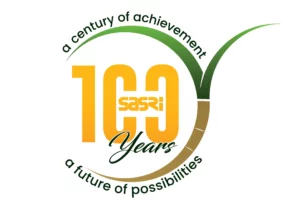
Director’s Message

Dr Shadrack Moephuli
100 years of growing sugarcane and research
In previous editions of The Link, readers were informed about the centennial celebrations of the South African Sugarcane Research Institute (SASRI), a division of the South African Sugar Association (SASA). As promised, we will continue to reflect on the history of this institution along with innovations introduced in the sugarcane industry that have supported many growers, miller-cum planters and others in employing people in rural communities, particularly in the Mpumalanga and KwaZulu-Natal provinces.
Preparations are under way for the centennial celebrations in various formats that will culminate in the main event to be held at the SASRI campus in Mount Edgecombe. To date, the organising committee has conducted a competition within SASRI that sought creative ideas for a centennial logo and associated message. This initiative led to several suggestions from SASRI’s innovative and energetic employees, resulting in the creation of the official centennial slogan (A century of achievement, a future of possibilities) and logo.

We thank the employees who participated for their contributions towards celebrating the historical and future contributions of SASRI to the sustainable growth and development of the sugarcane industry. More information will be forthcoming on these events to highlight the roles of various stakeholders, particularly the growers and millers.
In the last 100 years, SASRI and other research institutes globally have focused on crop improvement; that has largely been through breeding Saccharum officinarum (sugarcane) – known for high sugar yields; with Saccharum spontaneum (wild sugarcane) – known for resistance to biotic and abiotic stresses. The process of harnessing genetic diversity through selection and breeding over many years enabled the development of new varieties with genetic traits essential for sustainable sugar production. Such breeding programmes have resulted in varieties with pest and disease resistance, improved vigour, cane and sugar yields, ratooning ability, as well as adaptability to stress conditions.
Knowledge generated on sugarcane plant physiology, biochemistry, functional biology and recently, whole genome analysis, has provided insights for breeding programmes. In addition, expertise on crop performance under specific environmental conditions, including soil composition and water quality has been instrumental in enabling the development of suitably adapted varieties for sugarcane production.
“A Future of Possibilities”
Challenges, mainly from climate change, pest and disease outbreaks and economic performance suggest a need for the sugarcane industry to explore diversified uses of sugarcane. This presents an opportunity for a sugarcane-based economy that yields a diverse range of products suitable for net positive contributions to climate change, livelihoods and a sustainable future for all. Accordingly, this requires the development of new sugarcane feedstock capable of yielding high quantities of these new products when processed, such as biomass for energy co-generation, ethanol, bioplastics, biohydrocarbons, and biochemicals, to name a few.
Preliminary research at SASRI suggests innovations in the breeding programme, combined with better understanding of the crop physiology, biochemistry and biotechnology could be key towards the development of suitable varieties for biomass. For example, SASRI has developed hybrids (crosses of S. spontaneum and S. officinarium) for biomass that exhibit a thick canopy, high stalk population, excellent ratooning, low recoverable value percent (RV%), high fibre and high tonnes cane harvested. Such hybrids appear tolerant to abiotic stress, suggesting they can be cultivated in marginal areas; that in turn presents a potential to expand the area under sugarcane. In addition, such hybrids present opportunities to explore potential use in electricity co-generation, ethanol and paper production as well as a range of other specialty products.
To achieve a diversified sugarcane-based economy will require better understanding of new crop varieties, particularly suitable growing conditions for optimal and sustainable production. Knowledge and understanding will largely emanate for robust and innovative research by SASRI and other institutions. There may be a need for new skills towards the development and deployment of new varieties, both in research and on farms. However, much needs to be explored and evaluated to generate scientific evidence and knowledge to inform growing and processing conditions of new crop varieties suitable for a diversified sugarcane-based economy.
Small-Scale Grower Productivity
The sustainable success of the sugarcane industry will require focussed and long-term attention to improving yields and productivity among small-scale growers (SSG). Improved cane yields and productivity, particularly among small-scale growers is also a key element for effective supply to the mills of good quality product. Although several targeted interventions are required throughout the sugarcane industry for the sustainable success of the small-scale growers and land reform farmers, there’s critical need for effective scientific knowledge exchange. For example, ensuring and enabling adoption are critical elements of an effective extension and biosecurity service. To achieve this, SASRI has initiated a project to build capacity for foundational knowledge of soils, including estimating yield potential among extension specialists for small-scale growers. This project is conducted in collaboration with provincial departments of agriculture in Mpumalanga and KwaZulu-Natal through the Extension Venture Agreements (EVA).
To date, 55 SSGs in the Phumelela region, Pongola, have been visited and auger holes used to classify the soil and test soil nutrient status on each farm. Soil classification and nutrient analyses have revealed the presence of four major soil forms, effective rooting depths ranging from 30 cm to 120 cm, deficiency in phosphorus (P) in two of the soil forms, while the other two soil forms had P concentrations just above the minimum P threshold, and calcium (Ca) and magnesium (Mg) concentrations well above the threshold levels in all four soil forms.
Growers in the area are producing sugarcane yields that are lower than the soil potential, and further investigation through a grower survey revealed that there was a lack of knowledge on soil sampling, fertiliser application and management of soils for sugarcane production. Considering information gathered, extension specialists and growers will be engaged through participatory methodologies on how to apply recommendations from SASRI on their sugarcane fields.
The Link is a short newsletter that provides advice on key aspects for sustainable sugarcane production and productivity. We hope you will gain insights from these articles, gather additional information, especially from the experts at SASRI, and apply such knowledge in your farming practices. We hope you enjoy reading the articles.
